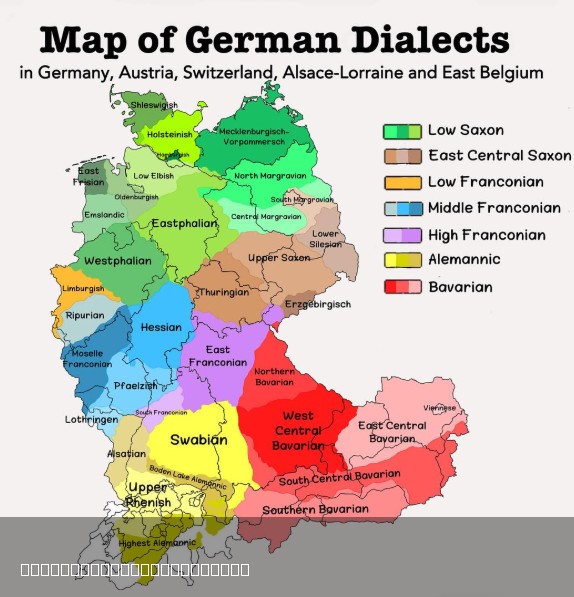Map of German Dialects in Europe


David Chen
Data Visualization Specialist
David Chen is an expert in transforming complex geographic datasets into compelling visual narratives. He combines his background in computer science ...
Geographic Analysis
What This Map Shows
This visual representation provides a comprehensive overview of the various German dialects spoken across Germany, Switzerland, Austria, and parts of France and Belgium. The map categorizes these dialects into distinct regions, highlighting the linguistic diversity within the German-speaking population. From the sharp, melodic tones of Bavarian to the guttural sounds of Low German, this map serves as a linguistic tapestry that weaves together the cultural identities of German-speaking communities.
Deep Dive into German Dialects
German is not just one uniform language; it is a fascinating mosaic of dialects that reflect centuries of history, migration, and cultural evolution. The dialects can be broadly classified into three main groups: High German, Low German, and Middle German.
High German (Hochdeutsch) is predominantly spoken in southern Germany, Austria, and parts of Switzerland. Interestingly, it is also the basis for Standard German, the version taught in schools and used in official communications. Bavarian and Swabian are two prominent dialects in this group, characterized by their distinct phonetics and vocabulary. For instance, in Bavarian, the word for 'bread' is 'Brot,' but it's often pronounced with a softer 'B' sound, almost like 'Broot.'
On the other hand, Low German (Plattdeutsch) is mainly found in the northern regions of Germany and along the coasts. This dialect retains many archaic features of the German language, making it a fascinating study for linguists. For example, the Low German term for 'house' is 'Huus,' which is quite different from its High German counterpart, 'Haus.' This divergence is a reflection of the historical and geographic factors that influenced language development in these regions.
Middle German dialects, such as the Hessian and Thuringian varieties, serve as a bridge between High and Low German. They exhibit unique characteristics that can vary considerably even between towns that are relatively close together. For example, the word for 'water' is 'Wasser' in Standard German, but in some Middle German dialects, it can be pronounced as 'Wasser' or even 'Wasservor.'
Interestingly, these dialects are not just about pronunciation; they also encompass unique vocabulary and grammatical structures. For instance, the use of the subjunctive mood varies significantly across dialects, affecting how hypothetical scenarios are expressed. This complexity contributes to the rich cultural heritage of the German-speaking world.
Regional Analysis
Taking a closer look at the regions represented on the map, we can see how geography plays a vital role in dialect formation. In Bavaria, the dialect is heavily influenced by the alpine culture, evident in the vocabulary related to agriculture and local traditions. For instance, terms related to farming practices or local festivals are often uniquely Bavarian, reflecting the region's deep-seated customs.
In contrast, the dialects spoken in the Rhine region, like Palatine German, are influenced by neighboring French and Flemish dialects, leading to a unique blend of linguistic features. This area has historically been a melting pot of cultures, and you can hear that in the way locals speak.
Switzerland presents an entirely different scenario. Swiss German varies not only from Standard German but also between Swiss regions. Dialects like Zurich German and Bernese German have unique phrases and pronunciations that can baffle even native German speakers from Germany. For example, the word for 'thank you' is 'Danke' in Standard German, but in Zurich German, you might hear 'Merci,' influenced by the French-speaking population nearby.
Significance and Impact
Understanding the diversity of German dialects is crucial for several reasons. Firstly, it reflects the rich cultural heritage and history of the German-speaking peoples. Each dialect carries stories of migration, trade, and social interactions that have shaped the identities of communities over generations.
Moreover, as globalization increasingly influences language, many dialects are at risk of fading away. Interestingly, younger generations may prefer Standard German due to its widespread use in media and education, leading to a decline in dialect usage. This could result in a loss of cultural identity and community cohesion. Therefore, efforts to preserve and promote dialects are essential for maintaining linguistic diversity.
In conclusion, the map of German dialects not only illustrates geographical distinctions but also serves as a powerful reminder of the dynamic and evolving nature of language. As we move forward, the challenge will be to balance the preservation of these unique dialects with the influence of a globalized world. Have you ever considered how language shapes our cultural identities? Understanding dialects can provide profound insights into the lives of people and their shared histories.
Visualization Details
- Published
- August 4, 2025
- Views
- 278
Comments
Loading comments...